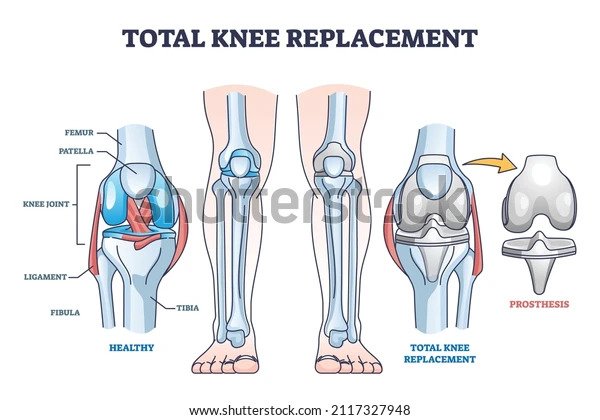Run After a Knee Replacement Surgery? Is it even possible? The most prominent question that athletic or casual runners ask after knee replacement surgery is whether they’ll be able to jog or run like before. Yes, it is possible, but only if you don’t give up.
Generally, most doctors advise runners to avoid any high-impact activity after knee replacement surgery. While running after knee replacement surgery has risk facets, it depends on your physical condition and the quality of the knee implant.
Today, high-quality implants and regular physical therapy with a balanced diet increase your running probability. How is this possible?
Let’s cut to the chase and learn different ways to resume running after knee replacement.

Can You Run After Getting A Knee Replacement Surgery?
Yes! Running after knee replacement surgery is possible, but only with great caution and strategic planning. Whether you’ll resume your activities depends on your physical condition, type of surgery, physical therapy, and muscle strength.
Besides, there are very few evidence-based recommendations on resuming high-athlete activities after knee replacement surgery. However, most orthopedic surgeons from AAOS advise runners to avoid high-impact activities such as running, jumping, or climbing for the first six months.
On the other hand, Dr. Kevin R Stone, an orthopedic surgeon, counsels runners to resume running gradually by rebuilding bone strength and muscles. Under the guidance of highly skilled physical therapists and fitness trainers, you can focus on muscle strengthening and joint flexibility.
Most doctors recommend that running is safer for you after six months when your bone is completely healed and your body is physically trained.
See expert tips to boost your knee replacement recovery
5 Ways To Increase Your Chances Of Running After Knee Replacement
Being a voracious runner and not being able to run for even a few months can make you feel upset and exhausted. To top it off, when most doctors advise runners to be highly cautious of not breaking down the implants, most runners never resume their sports and get depressed.
Here are five proven ways used by athletic runners to get back to running after knee replacement surgery.
1. Stay Active Before Your Surgery
Richard Donovan, an ultra-marathon runner, had undergone bilateral partial knee replacement in 2020. Aiming to run across America again, he went through multiple counseling sessions, rehabilitation programs, and physical training before and after surgery. And eight months after knee replacement surgery, Richard submitted the highest volcano in the world.
Keeping your body in shape before surgery through exercises and physical training helps you recover fast. If your hip and lower body muscles are active, they’ll regain their strength, ensuring greater muscle flexibility and strong bones, and reducing muscle soreness and fatigue.
One meta-analysis concluded that patients who actively participated in sports and other activities before knee replacement surgery resumed low-modern impact activities faster than those who were not active.
2. Follow Physical Therapy And Fitness Training Schedules
For the first six months of knee replacement surgery, your body hesitates to move freely as subtle movements can also feel painful. Doctors advise you to follow physical therapy sessions and train your body to regain muscle strength.
Remember that the first six months of healing are crucial. During these months, your recovery period depends on your general health. The stronger your muscles, the greater shock they’ll absorb.
When you start exercising on your own, make sure to focus on strengthening your core and hip muscles. Most doctors do not recommend putting too much stress on your knee for the first six months. In the beginning, they might counsel you to avoid hamstrings, quadriceps, and calf stretches. But for the time being, when your body starts adapting, you’ll regain your muscle strength.
3. Beat The Rush When Starting Out
Runners can never feel easy when they are at complete rest. As an avid runner, you might feel depressed about being unable to run. And once you regain your strength, there’s a chance that you’ll push yourself too hard to run just like before.
Remember, give time to your body to heal and gradually start with low-impact activities. Firstly, find some alternatives to running. If you’re an athletic runner, you’ll fear your knee implants will loosen if you run for longer miles. Talk to your doctor, clear all your doubts and do not give up. Follow these ways to keep your body active.
- Enroll yourself in rehabilitation programs
- Outdoor or indoor walking daily for 30 minutes
- Meditation or light yoga to keep your muscle moving
- Low-impact activities if you suffer from osteoarthritis
Once your body feels comfortable with low-impact exercises, you can go back to jogging within 8 to 12 months, depending on your recovery period.
4. Reduce The Load On Your Knee
When you start practicing low-impact exercises, that’s when you need to be very careful about not adding too much stress to your knees. Some steps that you can take immediately include:
- Work on your running form and not exert yourself to run for longer miles.
- Running slowly on even and soft surfaces to stabilize your running
- Continue your muscle-strengthening exercises even after you’ve started modern-impact activities.
- Maintain your body weight with healthy eating as too much weight on your lower body can stress your knees.
Invest in Well-Cushioned Running Shoes:
Once you’ve resumed your low-modern impact activities, most training experts advise you to buy new running shoes that minimize the stress on your knee and upper body. Well-cushioned shoes stabilize your running gait and add extra support by absorbing high forces.
To find out the best running suited for you, read Best Shoes To Wear After Knee Replacement Surgery.
5. Find Alternate Exercises Before You Resume Running
Do not rush yourself and focus on one activity. Otherwise, you’ll push your body harder, damaging your knee joint. AAOS recommends you incorporate a range of alternative activities to high-impact ones. For instance, most knee replacement patients cannot tolerate running even after complete healing. In this case, you can switch to aerobic exercises.
After talking to your doctor or therapist, you can start with walking, cycling, or biking. Likewise, swimming is the best aerobic exercise to train your lower body muscles after knee replacement surgery.
With your instructor or counselor, you can make weekly schedules and substitute running with low-impact exercises to reduce the burden on your knee. Make sure to follow your doctor’s protocols and contact your doctor immediately as soon as you feel pain.
Precautions to Take While Running With Artificial Knee?
Some cautions to take while running with an artificial knee are:
- You should only run if your orthopedic surgeon has given you a green signal.
- Talk to your doctor or physical therapy expert to check your running gait.
- Change your running form if you’re a heel strike runner. Heel striking transfers pressure from foot to knee, increasing the risk of wearing out your knee implant.
- Do not continue running if you feel pain in your lower leg.
- Running for longer miles without a break can lead to complications.
- Maintain your physical strength by warming up and eating a balanced diet.
FAQ’s
Q. 1 Can You Play Tennis After Knee Replacement?
Tennis is a beloved sport that has been enjoyed by many people around the world for centuries. Tennis can be an enjoyable way to stay active and keep fit, however, the physical demands of the sport can be too much for some people. In particular, people who suffer from knee problems may find that they are unable to play tennis without suffering from pain or discomfort. Knee replacement surgery can be a great solution for these individuals, however, some may be wondering if it is still possible to play tennis after undergoing this procedure.
The answer to this question is yes, you can play tennis after knee replacement surgery. However, it is important to note that you will likely need to take some extra precautions and make some adjustments to your game in order to ensure your safety and comfort.
You may also need to use a brace or other support device to help reduce the strain on your knee while playing. Additionally, you should consider using a lighter racquet and taking more breaks between points in order to reduce the stress on your knee.
Overall, playing tennis after knee replacement surgery is possible and can be a great way to stay active and healthy. However, it is important to take the necessary precautions and take your time in order to ensure your safety and comfort. With the right approach, anyone can enjoy playing tennis after knee replacement surgery.
Q.2 Can You Jog After Knee Replacement?
One of the most common questions asked by patients following knee replacement surgery is whether or not they can jog.
The answer to this question largely depends on the individual and their level of activity prior to the surgery. Generally speaking, it is recommended that patients wait at least four to six months before attempting any type of jogging. This gives the knee time to heal and the muscles to strengthen. During this time, physical therapy can be beneficial in helping to slowly build up strength and flexibility.
Once a patient has been cleared by their doctor to begin jogging, it is important to start slowly and increase the intensity gradually. Low-impact aerobic exercises such as walking, swimming, and cycling can be a good way to begin. As the patient’s strength and endurance build, they can begin to increase the speed and duration of their workouts.
Also, there are a few things to keep in mind when jogging after a knee replacement. First, it is important to warm up and cool down before and after each session. This helps to prevent injury and reduce the risk of soreness. Second, it is important to give the body time to rest between workouts. Finally, it is important to seek medical advice if any pain or discomfort is felt.
Conclusion
All in all, talking to your therapist and orthopedic surgeon about your goals and expectations concerning knee replacement surgery is necessary to decide your recovery period. Once you’ve maintained your muscle strength before and after knee replacement surgery, there are high chances that you’ll be able to resume running just like before.
Remember that you’ll face several challenges to get back on track but once your body gets used to your artificial knee, you’ll get back to normal activities.
